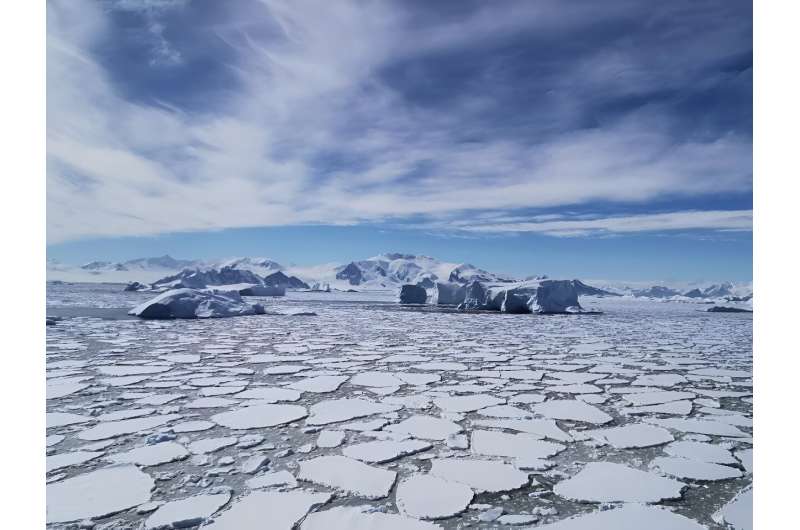This article has been reviewed according to Science X's editorial process and policies. Editors have highlighted the following attributes while ensuring the content's credibility:
fact-checked
peer-reviewed publication
trusted source
proofread
Melting ice, falling snow: Sea ice declines enhance snowfall over West Antarctica

As the world continues to warm, Antarctica is losing ice at an increasing pace, but the loss of sea ice may lead to more snowfall over the ice sheets, partially offsetting contributions to sea level rise, according to Penn State scientists.
The researchers analyzed the impacts of decreased sea ice in the Amundsen Sea in West Antarctica and found the ice-free ocean surface leads to more moisture in the atmosphere and heavier snowfalls on the ice sheet, the team reported in the journal Geophysical Research Letters.
While the additional snowfall is not enough to offset the impacts of melting ice, including it in climate models may improve predictions of things like sea level rise, said Luke Trusel, assistant professor of geography at Penn State and co-author of the study.
The Antarctic ice sheet plays a significant role in global sea level dynamics. As one of the world's largest reservoirs of freshwater, any change in its volume directly impacts sea levels. Trusel noted that while popular attention is often on visible processes like chunks of ice breaking away, or calving, and floating away as icebergs, more subtle interactions—like snowfall on the ice sheet—can be equally significant.
"For a place like Antarctica, which is just massive, the amount of snow falling on top of the ice sheet is as important or even more important than other processes like meltwater or ice breaking off," Trusel said. "We're tracking both snowfall and melt to understand both ends of the equation—what takes from sea level and what gets returned to the ocean. We want to know how those factors are impacting the ice sheets."
The primary source of snowfall in Antarctica is evaporation from the surrounding oceans, with sea ice playing a pivotal role in modulating this process, according to researchers.
"Sea ice is significant," said Jessica Kromer, a doctoral candidate at Penn State and lead author. "It reflects sunlight, aids in cooling the planet and influences interactions between the atmosphere and ocean, including oceanic evaporation. We found that precipitation varies so much year to year. In some years, precipitation can take away from sea level or lessen the impact of the ice discharged from the sheets."
Using satellite observations and climate data, the researchers analyzed the relationship between the ocean surface, atmosphere and Antarctic ice sheet's mass. Their findings highlighted that during periods of reduced sea ice, the atmosphere retained more moisture. This moisture, when reaching the colder ice sheet boundaries, condenses, leading to increased snowfall.
The findings, researchers said, suggest that as global temperatures inch upwards and Antarctica warms, shrinking sea ice levels will amplify oceanic evaporation and consequent precipitation over Antarctica. This increased snowfall can momentarily stave off rising sea levels. However, sea levels will still rise overall.
"With global warming, there's an expectation of reduced sea ice," Trusel said. "As sea ice diminishes, there could be increased evaporation from the ocean leading to more precipitation over Antarctica. While this might appear to offset the loss of sea ice, the implications are multifaceted. Increased snowfall in Antarctica might slow the sea level rise, but it's essential to recognize that the ice sheet will continue to contribute to rising sea levels."
The scientists identified a feedback loop between sea ice and atmospheric water vapor. A more ice-free ocean surface intensifies evaporation, contributing to increased atmospheric water vapor. This enhanced moisture causes a locally amplified greenhouse effect, resulting in heightened downward longwave radiation, which subsequently reduces sea ice the next month.
Kromer highlighted recent satellite data, which indicates notable changes in the patterns of sea ice.
"While Arctic sea ice has been rapidly declining over the satellite record, the Antarctic experienced a slight increase until 2015, followed by a sharp decline in 2016," Kromer said.
"In 2022, we witnessed a new record low, and this year's levels are even lower, significantly below previous observations. These recent rapid changes in Antarctic sea ice highlight the urgency of understanding their causes and their potential impact on the Antarctic ice sheet."
The team's findings emphasize the need for refining current climate models to enhance their predictive accuracy, the scientists said.
"If we aim to project future sea level changes with precision, it's essential to enhance our models, particularly in representing sea ice dynamics," Trusel said.
More information: Jessica D. Kromer et al, Identifying the Impacts of Sea Ice Variability on the Climate and Surface Mass Balance of West Antarctica, Geophysical Research Letters (2023). DOI: 10.1029/2023GL104436
Journal information: Geophysical Research Letters
Provided by Pennsylvania State University




















